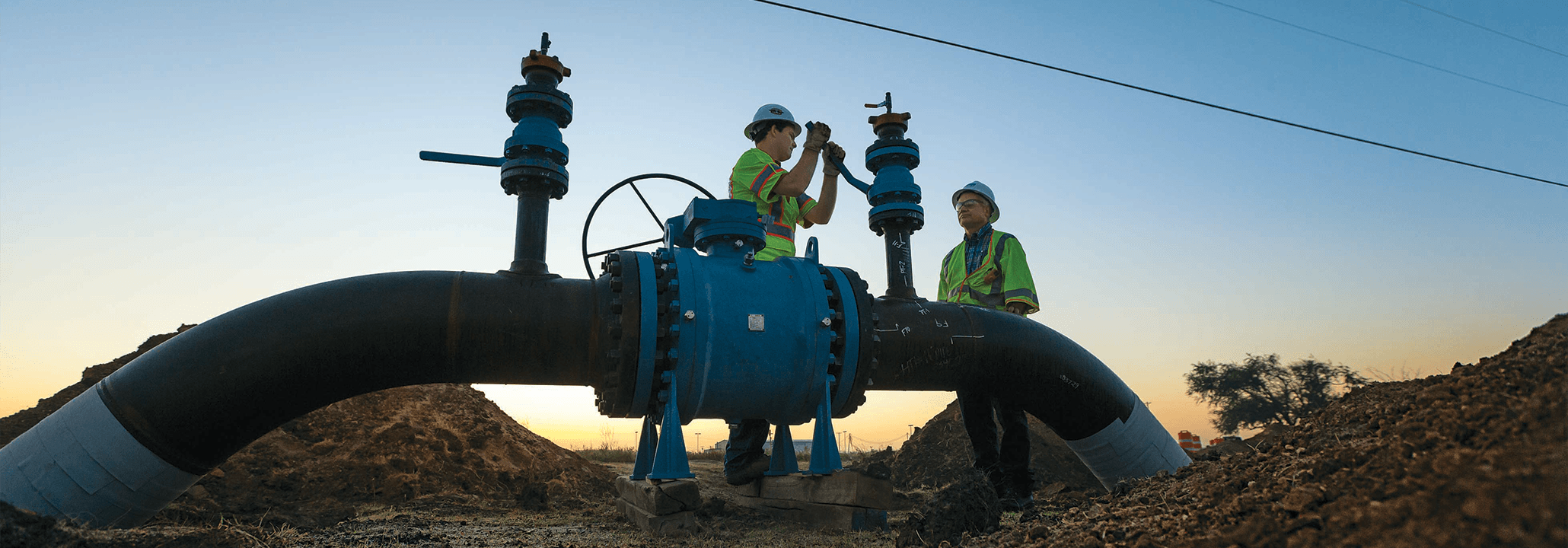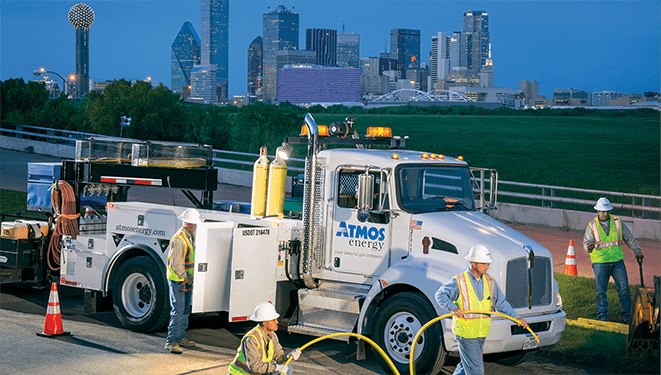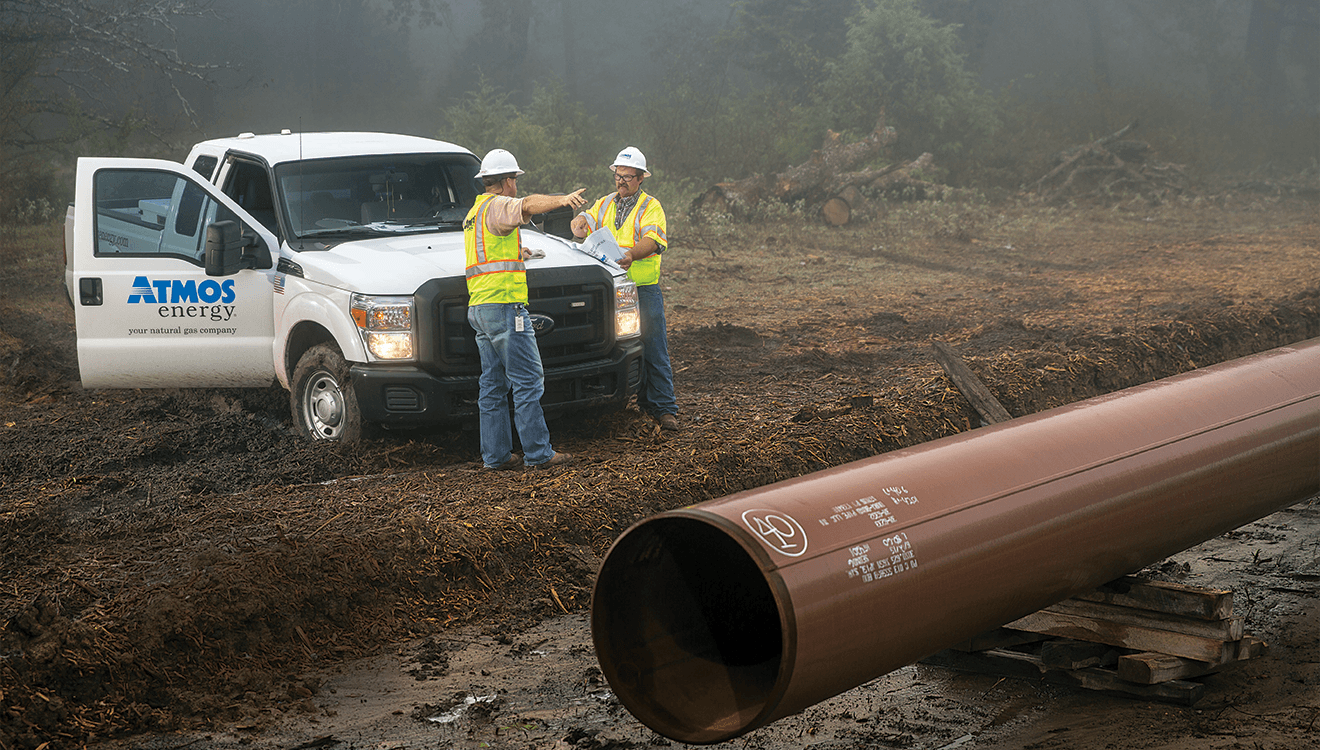RECENT SEARCHES

Our Pipeline System
Atmos Energy operates a vast network of natural gas pipelines to safely and reliably serve more than 3 million customers in eight states. We maintain more than 76,000 miles of distribution and transmission pipelines, plus thousands of smaller “service lines" that connect natural gas directly to homes and businesses.
We also allow pipeline interconnections with third-party companies for the transportation of natural gas for our system and customer supply requirements.
Establishing Pipeline Interconnects
Requests for new pipeline interconnections must be approved by Atmos Energy or Atmos Pipeline–Texas, depending on the interconnect location. Requests will be evaluated for impacts on gas quality, operational integrity, pigging requirements, capacity limitations, operating pressures, odorization, customer service, and other factors.
Atmos Pipeline - Texas in North, Central, or East Texas
Access request forms and procedures for interconnects on Atmos Pipeline - Texas in North, Central, or East Texas.
Colorado, Kansas, Kentucky, Louisiana, Mississippi, Tennessee, Virginia, or West Texas (including the Panhandle)
All new receipt point interconnections will require the execution of an Interconnect Agreement and submission of the Application for Interconnect (Standard - Traditional Pipeline or Wells or RNG - Renewable Natural Gas). If the interconnection cannot be made at the requested location, Atmos Energy will inform you of any possible alternate locations.
Here are the steps required to establish a new well meter or common point meter:
Step 1: Requestor completes the Application for Interconnect (Standard or RNG) and email to Atmos Energy.
Complete the form as fully as possible; incomplete forms will result in delays. To speed the process, a sample analysis, if available, may be submitted with the form.
Step 2: Parties coordinate procurement of a gas sample and/or sample analysis of the well(s).
If a representative sample analysis of the gas is not submitted with the application, Atmos Energy will contact the customer to coordinate procurement of a well sample. Samples obtained by Atmos Energy will be analyzed in a laboratory we designate. Tests for H2S and hydrocarbon dew point may also be performed at the well site during the sampling process. Atmos Energy reserves the right to obtain its own sample from the gas source.
*Samples are not required for prospective RNG Projects.
Step 3: Atmos Energy reviews the request and proposes the parameters for the interconnect measuring station.
An Atmos Energy representative will coordinate the collection of all required information (arrange for the gas analysis, capacity study, and facility cost estimate, for example). If the gas quality does not satisfy our specifications, we will review the situation with the applicant and discuss potential solutions. If the gas quality satisfies current quality specifications, we will study whether sufficient capacity is available on the Atmos Energy system and assign an engineering staff member to you. We will propose an appropriately sized meter, measuring station equipment and lot size for the interconnect station. An Interconnect Agreement outlining responsibilities for both parties and the required cost reimbursement will be forwarded to the customer for execution prior to initiating work on the interconnect station.
Step 4: Discuss options for the measuring equipment purchase, construction and ownership of the proposed measuring station prior to Atmos Energy preparation of the Interconnect Agreement.
We have adopted two alternative methods for the purchase, construction, and ownership of measuring stations:
- A turnkey project by Atmos Energy for the tap, connecting pipeline (up to 100 feet) and measuring station and where Atmos Energy owns, operates and maintains all facilities installed by Atmos Energy. Such projects are fully reimbursable and include the sum of Atmos Energy labor costs, equipment costs and overheads incurred in providing such a measuring station connection, plus contribution-in-aid-of-construction ("CIAC") taxes.
- A project for which the customer is responsible for providing a site lot for the measuring station and also procures, constructs and installs most of the equipment for the measuring station, all to Atmos Energy's current interconnect specifications. In such cases, the ownership of the measuring station usually remains with the customer, while the downstream pipeline and tap and SCADA is owned by Atmos Energy. In this situation, the customer would reimburse Atmos Energy for the tap, connecting pipeline, SCADA Equipment (and CIAC taxes), inspection by Atmos Energy of work performed by the customer or customer's contractor at the measuring station, and costs associated with the commissioning of the measuring station.
We can also discuss variations of these two methods but in all cases Atmos Energy will operate the measuring station, connecting pipeline (downstream of the measuring station) and the tap. The customer will own, operate and maintain the pipeline upstream of the measuring station.
Step 5: Customer executes the Interconnect Agreement and remits reimbursement funds to Atmos Energy.
The customer delivers the executed Interconnect Agreement, with a check for the reimbursable portion of the work, to Atmos Energy. We will contact the appropriate engineering, right of way, field operations and construction departments.
Step 6: Parties coordinate construction activities.
The customer and Atmos Energy will coordinate procurement of all necessary right of way permits and selection of a mutually agreeable meter and tap locations on existing Atmos Energy pipeline. Materials are then provided from stock, or ordered, and the tap and/or meter installed.
Step 7: Atmos Energy commissions the measuring station.
After completion of construction, Atmos Energy will commission the measuring station. This involves programming the flow measurement devices and calibrating equipment to accurately measure gas use. Once commissioning is complete, we will schedule gas to start flowing upon receipt of the customer's nomination and subsequent confirmation for transportation service.
Download Interconnect Documents for Colorado, Kansas, Kentucky, Louisiana, Mississippi, Tennessee, Virginia, or West Texas (including the Panhandle)
- Interconnect Agreement
- Application for Interconnect (Standard - Traditional Pipeline or Wells)
- Application for Interconnect (RNG - Renewable Natural Gas)
- Piping and Instrumentation Diagram
- Standard P & ID Legend
- Typical 2" Measuring Station
- Typical Plan, Sections, and Isometric Layout
- Typical 2" Regulator and Meter Spools


Atmos Energy is engaged in regulated utility operations. Atmos Energy Corporation. All Rights Reserved.